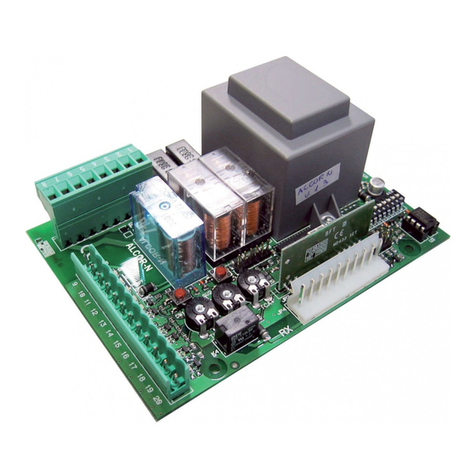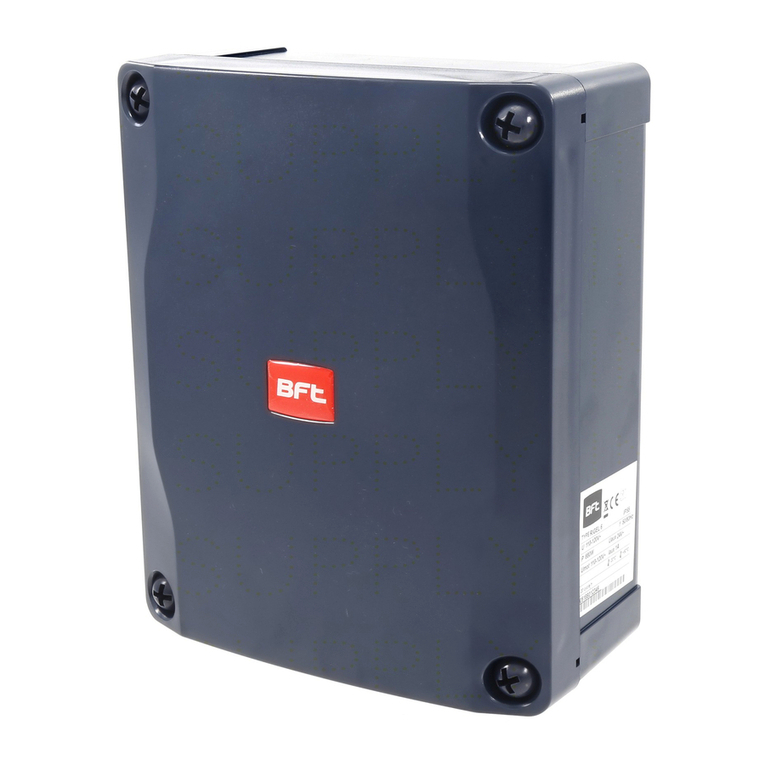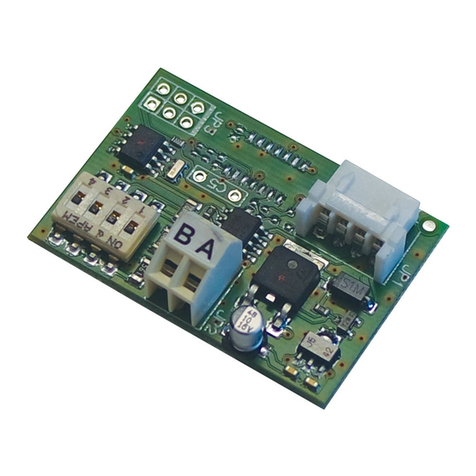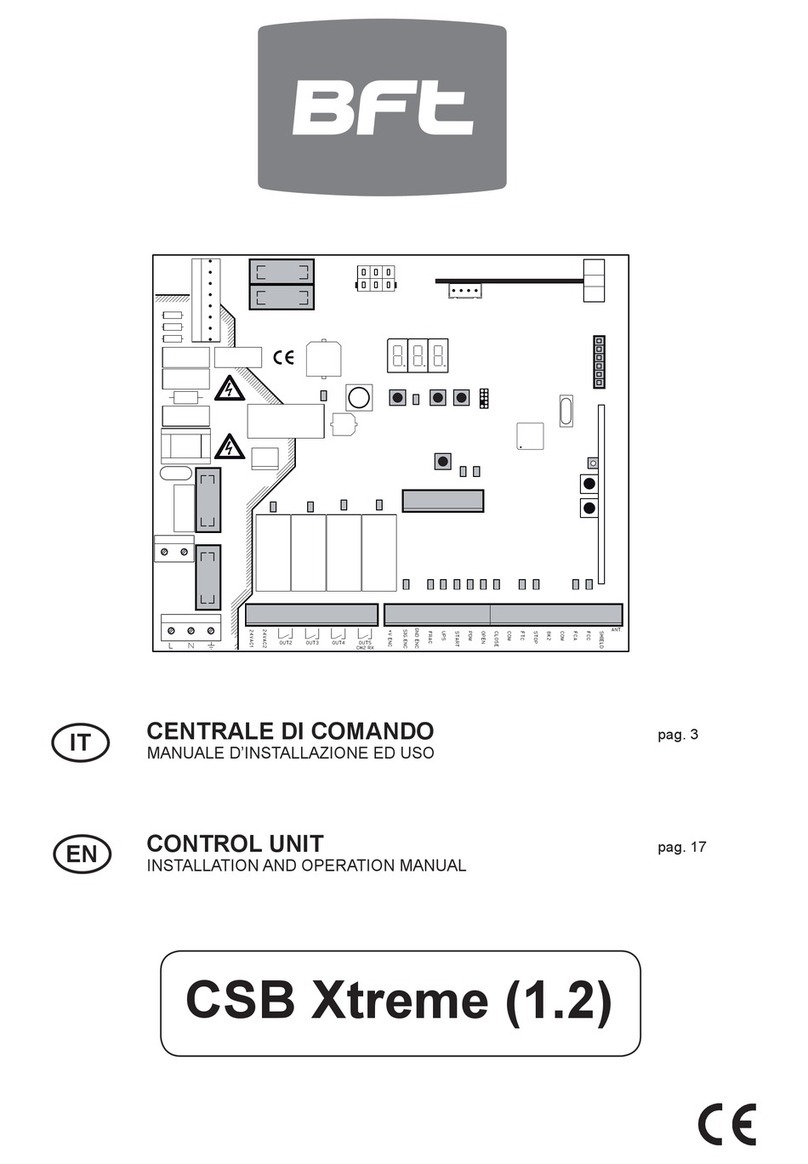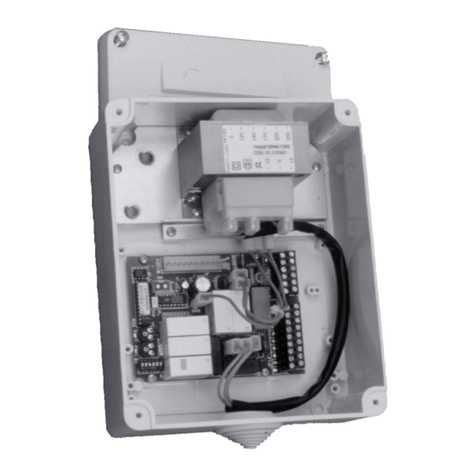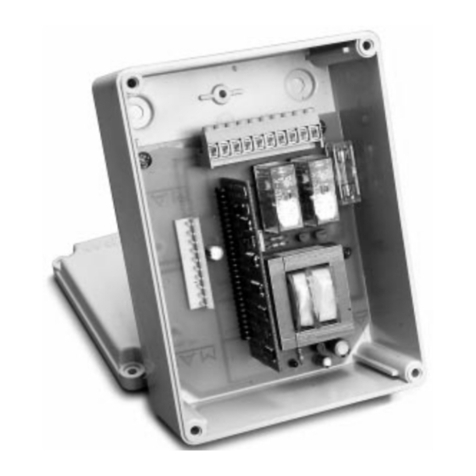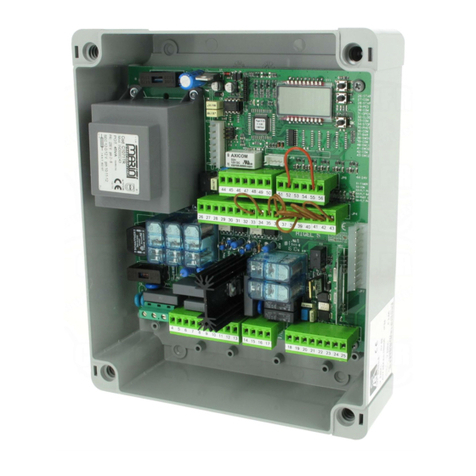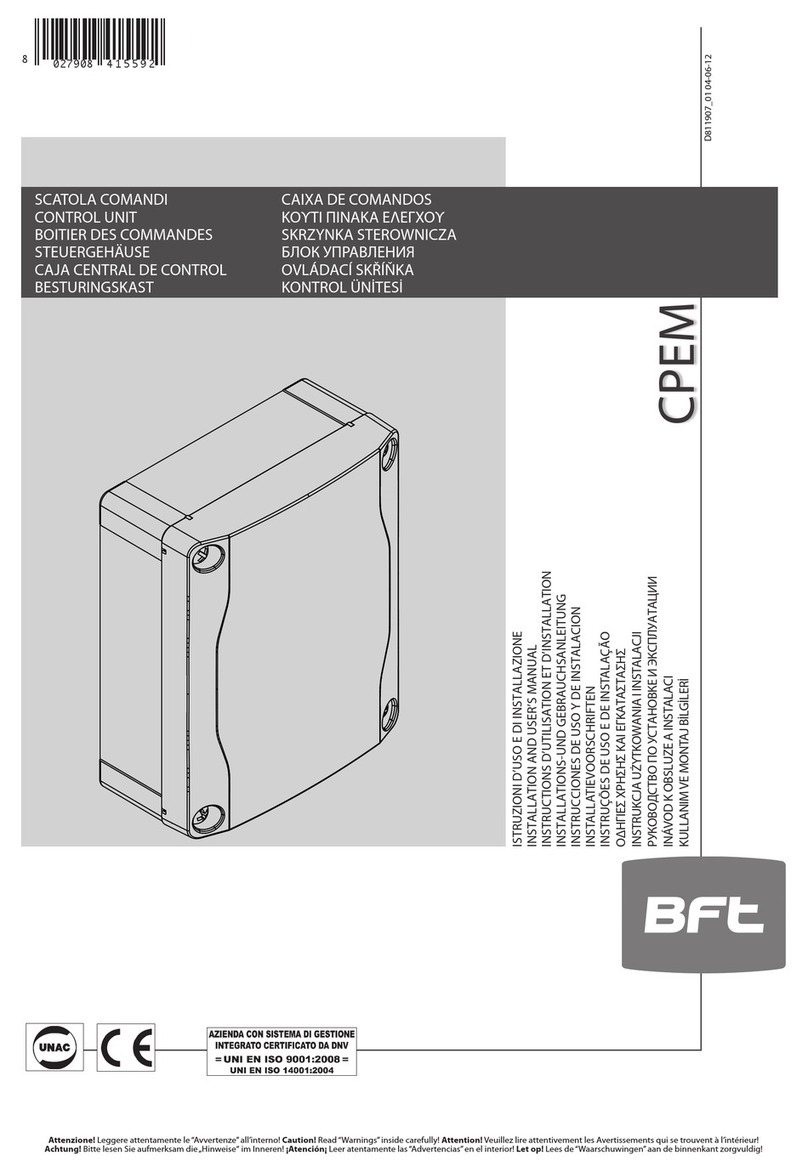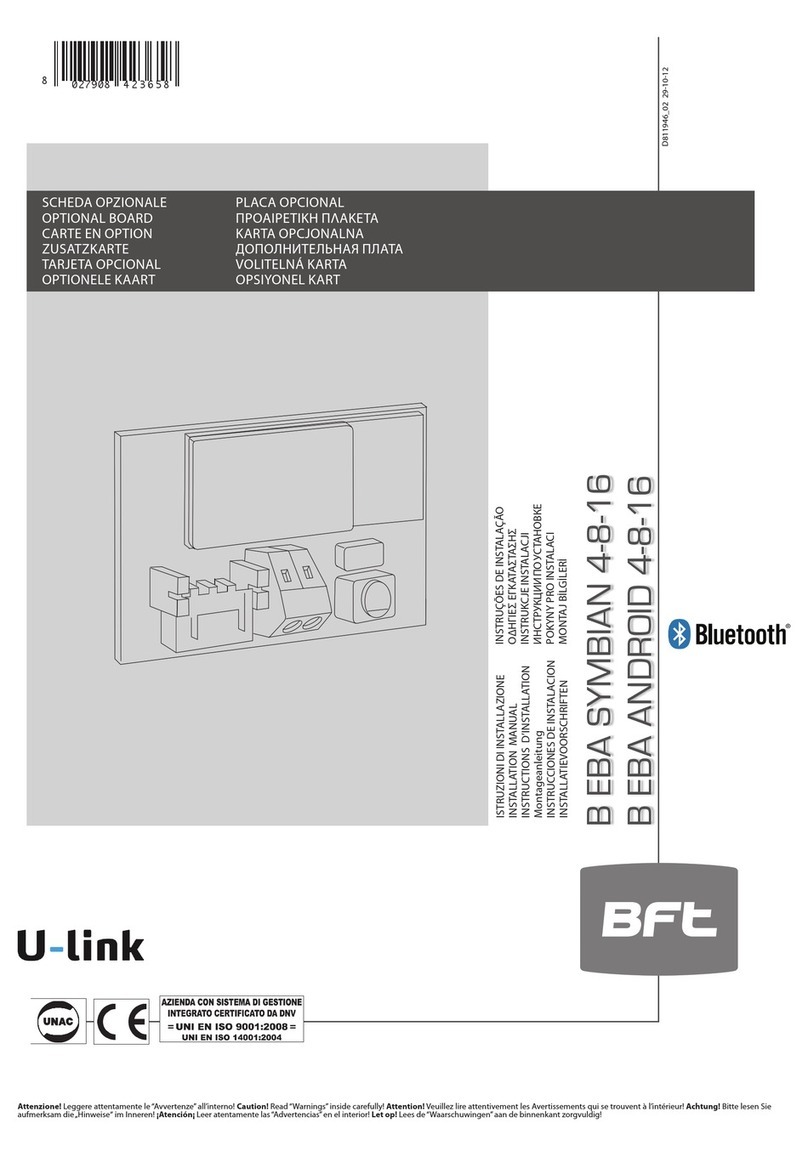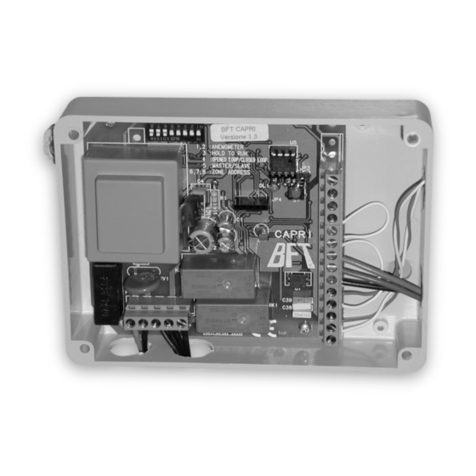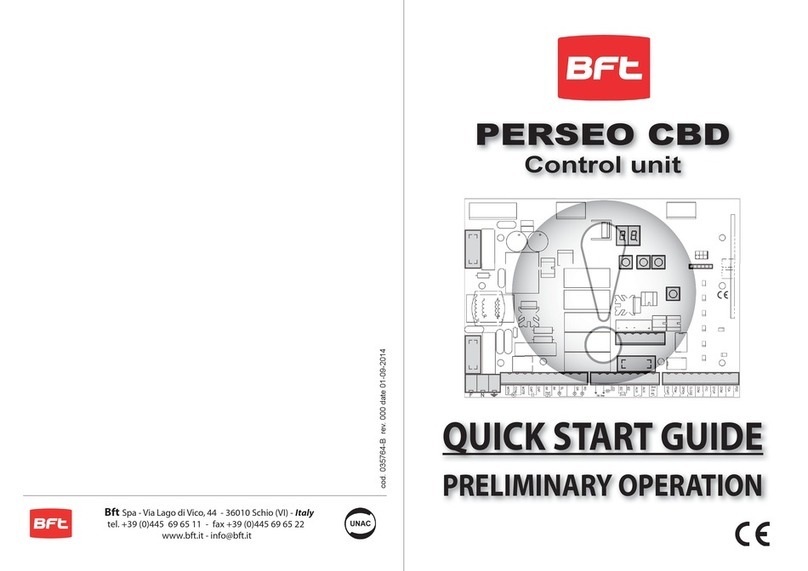
RIGEL 4 -
5
GB
Thankyouforbuyingthisproduct,ourcompanyissurethatyouwillbemore
than satisfied with the product’s performance.
The product is supplied an “INSTRUCTION MANUAL” which provides
importantinformationaboutsafety,installation,operationandmaintenance.
This product complies with the recognised technical standards and safety
regulations. We declare that this product is in conformity with the following
EuropeanDirectives:89/336/EECand73/23/EEC(amendedbyRL91/263/
EEC, 92/31/EEC and 93/68/EEC).
IMPORTANT NOTE
For wiring and installation operations, refer to
the current standards and follow the main technical principles
ensuring good performance.
1) General outline
This control unit with microprocessor has been designed to control one or
two motors with a power up to 375 W.
ThecontrolunitisequippedwithDip-switchesandtrimmerswhichallowthe
configuration and calibration of the unit respectively. The functions of the
Dip-switchesandtrimmersaswellastheeffectsgeneratedbythealteration
to the initial setting are described in the following paragraphs while their
arrangement on the board is shown in the diagram of figure 1.
To facilitate maintenance and replacement operations, the board features
a removable terminal board with 40 terminals. The wiring diagram of the
board is shown in figure 2.
To facilitate installation operations, the board is supplied with a series of
pre-wired jumpers.
The jumpers refer to the following terminals: 31-33, 32-33, 33-34, 35-36,
36-37, 38-39, 39-0.
Onrequest, the SSR4 board controlling two traffic lights canbefitted to the
board; the operation and specifications of the traffic light board are con-
tained in the relevant specific section while the wiring diagram and a pos-
sible arrangement is shown in figure 3.
Rigel 4 can be completed with an additional SPL board (figure 4) and an
automatic thermostat for motor pre-heating. For wiring diagram, see fig. 5.
Thelimitswitchinputsforclosingandopeningmanoeuvresareseparatefor
each motor.
If the sensing edge is activated, the special separate connection reverses
themovement direction for a period of 3 seconds (a subsequent command
continues the movement in the reverse direction).
A 12Vac electric lock can also be connected; the power excitation lasts
about 3 seconds.
The continuous dutyEBP electric lock can be connected in parallel to the
blinker (230Vac).
A courtesy light output has been provided with a time range up to 90 sec-
onds from the last command given.
2) Technical specifications
Mains power supply 230V±10% 50Hz (different voltages
available on request)
Mains insulation/low voltage > 2MOhm 500Vdc
Dielectric strength/low voltage 3750Vac per 1 minute
Motor output current 5A max
Motor relay switching current 15A
Max. motor power 1motor375W,2motors375W+375W
Courtesy light Max 150W time set up to 90 seconds
from last command
Power supply for accessories 24Vac (0.5A maximum absorption)
Electric lock output 12Vac (2A maximum absorption)
Gate-open warning light 24Vac 3W max
Blinker 230V 40W max
Fuses see figure 1
3) Terminal board connection
JP1
1-2 Power supply 230Vac±10%, 50-60Hz (1 phase, 2 neutral).
JP6
3-4-5 Connection motor 1 (may be delayed in opening); terminal 4-5
phase and capacitor, terminal 3 neutral.
6-7-8 Connection motor 2 (may be delayed in closing); terminal 7-8
phase and capacitor, terminal 6 neutral.
9-10 Output for 230Vac flashing beacon (40W max) and for electronic
lock EBP 230Vac.
11-12 Courtesy light 230Vac (150W max) delayed for 90s after the last
operation.
JP4
13-14 Gate open warning light 24V (3W max).
15-16 24Vac output for photocells etc. (6W max, 25mA).
17-18 Output for 12Vac lock (2A max).
19-20 Antenna input (19 signal, 20 braiding).
21-22 Output of second radio channel (if 2nd channel receiver installed).
JP5
23-24 Start command (n.o.), START I for traffic light.
24-25 Start command (n.o.), START E for traffic light.
26-27 Pedestrian gate - start command
28-30 Open command (n.o.)
29-30 Close command (n.o.)
31-33 Stop command (n.c.)
32-33 Photocell input / safety circuit (n.c.)
33-34 Second safety circuit. Safety edge.
35-36 Open limit switch motor 1 (n.c.)
36-37 Close limit switch motor 1 (n.c.)
38-39 Open limit switch motor 2 (n.c.)
39-40 Close limit switch motor 2 (n.c.)
4) Functioning logic
TheconfigurationofthecontrolunitRigel4withmicroprocessorisobtained
by means of the Dip-switches.
Dip-switch 1 Photocells (FCH)
ON - Inhibits the operation of the photocell during the opening movement
and immediately reverses the movement direction in the closing phase as
soon as an obstacle is detected by the photocell.
OFF - When the photocell detects an obstacle and the gate is closing, the
movementof the gate is immediately stopped; as soon as the obstacle has
been removed, the gate opens. If an obstacle is detected by the photocell
whenthegateisopening,itstopsimmediately;assoonasthe obstaclehas
been removed, the gate completes the opening stroke.
Dip-switch 2 Impulse blocking device (IBL)
ON - The start impulse has no effect on opening.
OFF-Thestartimpulseonopeningcausesthestopofthe gate(Dip6OFF)
or the reverse (Dip 6 ON).
Dip-switch 3 Automatic closing (TCA)
ON - Carries out the automatic closing of the gate after a dwell time set on
theTCAtrimmer.Theautomaticclosingisactivatedwhen:thegatereaches
theopeningendofstrokeposition,theworkingtimeonopeninghaselapsed,
the gate is stopped during the opening phase by a start impulse.
OFF - Inhibits the automatic closing.
Dip-switch 4 Ram blow (HAMMER)
ON-Beforeopeningthegate,itpushesforabout2secondsonclosing.This
permits an easier release of the electric lock.
OFF - Inhibits the ram blow.
Dip-switch 5 Motor 1 opening delay (DELAY OPEN)
ON - Motor 1 starts with a delay of about 3 seconds on opening.
OFF - Motor 1 starts with a delay of about 0.5 seconds on opening.
Dip-switch 6 2 or 4-step logic (2P/4P)
ON- When a startimpulseis given while thegateis moving, the movement
direction will be inverted (2 step logic).
OFF - When a start impulse is given while the gate is moving, the gate will
stop;asubsequentimpulsewillcausetheinversionofthemovementdirec-
tion (4 step logic). Note: the start impulse has no effect when the Dip 2 is
OFF during the opening phase.
Dip-switch 7 Pre-alarm (PREAL)
ON - The blinker lights up about 3 seconds prior to motor start.
OFF - The blinker lights up as soon as the motors start.
Dip-switch 8 Block persistence (BLOCK)
ON - If the motors remain still in the complete opening or closing position
for more than one hour, they are pushed for about 3 seconds in the end of
stroke direction. This function is performed every hour.
OFF - Inhibits the block persistence function.
Note:In thecase ofoil-hydraulicmotors, thisfunction isusedto compensate
for any possible oil volume decrease due to a temperature decrease during
long pauses (for example during the night) and to keep the grease slightly
heated in all the electromechanical actuators for swing gates.
WARNING:Donot usethis functionfor slidinggates orwithout appropriate
mechanical blocks.
Dip-switch 9 Reduced or standard working time range (S.TW)
ON - Working time TW between 1‚ 40 seconds (TW.PED from 1 to 20 sec-
onds).
OFF - Working time TW between 30‚ 180 seconds (TW.PED from 15 to 90
seconds).
Dip-switch 10 Gate-open/close control (U.P.)
Operates on the signals connected to the terminals 28-29.
ON - Hold-to-run operation: the manoeuvre lasts for as long as the control
key is pressed.
OFF- Separate gate-open/close automatic control: one impulseopensthe
gate if closed and vice versa.















